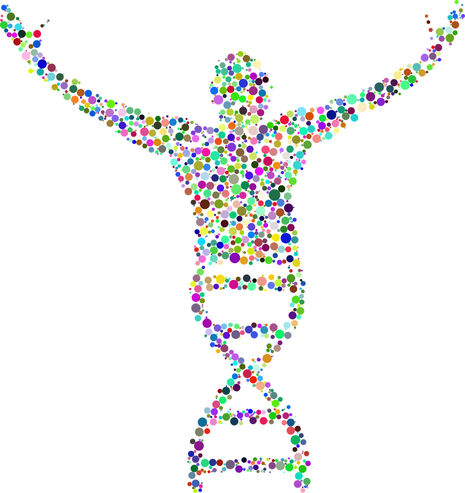What makes you, you? The complications behind race and DNA ancestry tests
Yan-Yi Lee discusses scientific literacy and the concept of “race” when interpreting DNA ancestry test results.

You spit in a tube, toss it in the mail, and anxiously wait for two long months. Finally, the results are in—those long-anticipated results of your ‘genetic origins’. Your heart pounds as you read something approximate to ‘78% Irish, 13% West Asian, and 9% Polynesian’ on a colourised pie chart. Your mind runs wild as you sink into history, wondering how your ancestors came to be. But what do these numbers actually say about your race, and how can you critically make sense of all this?
With the genetic testing industry blossoming in the past decade, such DNA ancestry tests (see direct-to-consumer racial admixture tests) seem to have risen exponentially in popularity. Putting aside the excitement that comes with this cutting-edge invention, a matter of concern pertains to scientific literacy when interpreting test results. Not only are scientists increasingly worried about whether consumers understand the limitations of such testing, but there have also been concerns over socio-ethical consequences that may arise with incorrect result interpretations.
Consumers of these test kits should first have a general understanding of what DNA is (well, aside from the fact that it looks like a twisted ladder!). In short, DNA contains unique genetic information about ourselves, and genes are short sections of DNA that determine our physical characteristics (e.g. eye colour, hair colour)—characteristics that help people build superficial, visual perceptions of whether someone could be ‘Hispanic’, ‘East Asian’, and so forth. Chromosomes, on the other hand, are tightly-coiled DNA that determine things like biological gender. But here’s the thing—much unlike gender, there is no such thing as a race chromosome.
Therefore, the primary caveat of DNA ancestry tests is that results are by no means definite— scientists merely observe your DNA patterns to make guesses of where your ancestors might have been. When you provide a saliva sample, scientists take a closer look at certain markers in your DNA, which has to do with single nucleotide polymorphisms (SNPs). The letters that comprise the SNPs at certain positions (namely, A, T, C, and G) may be associated with a population (e.g. Native American, South Asian), thus giving potential to paint a partial picture of your ancestral past. The tricky thing about this all is that SNPs at certain positions may exist among various populations across continents. If we were to take this example from Ancestry, SNP rs122 would occur in three populations (Native American, Swedish, and English) and with different frequencies, so results are estimates at best even at high confidence levels. Equally noteworthy is that testing companies usually work with their own available database of DNA data (‘reference panels’), which explains why your genetic results may vary every few years or when tested by different companies.
“...could what we define as ‘race’ be none other than a social construct?”
Such complications are humbling—they reveal how it is fundamentally impossible to classify people into neat, starkly different categories on the basis of race. Connections between genes and what constitutes ‘race’ is a remarkably complex subject matter—so much so that some scientists (particularly anthropologists and sociobiologists) question the existence of distinct biological races among us Homo sapiens. As such, it is imperative to recognise that our understanding of race evolves continuously in contemporary scholarship. The arguments of prominent science journalists such as Angela Saini bestow us the courage to think: could what we define as ‘race’ be none other than a social construct?
So, if the premise of race is more social than biological, how are we to make sense of race in DNA ancestry testing results? This question is hugely philosophical and while scientists may not have a concrete answer to this, we may surmise that consumer motivations for taking DNA ancestry tests have strong potential to govern interpretations of race. For a great many consumers, the purpose of taking a DNA ancestry test is driven by pure, light-hearted curiosity— none other than to make a preliminary exploration of where their ancestors might have come from and perhaps even to reconnect with long-lost relatives. In some not-so-innocuous cases—sometimes among those with a hidden racist agenda— the stark categories outlined in the results of DNA ancestry tests may fuel racial essentialism, feeding the dangerous misconception that humans can, in fact, be demarcated precisely into boxes.
So what is implied from all this? When people are unaware of the limitations of DNA ancestry tests, they may develop the false notion that these tests are omnipotent and implicitly believe that identities can be easily assigned by a simple spit. It is therefore imperative that we continuously educate people on the concept of race and what those pie chart numbers mean in an ancestry test (one could question whether a spectrum rather than a pie chart would be more informative when illustrating results). It is upon us to disseminate healthy mindsets to adopt when interpreting ancestry test results, and also to inspire mindfulness of how the information is perceived. Being able to differentiate the essence of ‘race’ and ‘ancestry’ is likewise something to consider down the line.
In an era where direct-to-consumer DNA testing appears to be on the rise, it is pivotal to consider how the technology can best serve consumers (and on a different but equally important note, how best to foster awareness on genetic testing data privacy). Only with critical lenses will we be able to ultimately appreciate the inspiringly diverse essence of our genes and understand what it means to be part of the human race.
 Comment / Plastic pubs: the problem with Cambridge alehouses 5 January 2026
Comment / Plastic pubs: the problem with Cambridge alehouses 5 January 2026 News / Cambridge businesses concerned infrastructure delays will hurt growth5 January 2026
News / Cambridge businesses concerned infrastructure delays will hurt growth5 January 2026 News / Cambridge academics stand out in King’s 2026 Honours List2 January 2026
News / Cambridge academics stand out in King’s 2026 Honours List2 January 2026 News / AstraZeneca sues for £32 million over faulty construction at Cambridge Campus31 December 2025
News / AstraZeneca sues for £32 million over faulty construction at Cambridge Campus31 December 2025 Interviews / You don’t need to peak at Cambridge, says Robin Harding31 December 2025
Interviews / You don’t need to peak at Cambridge, says Robin Harding31 December 2025










